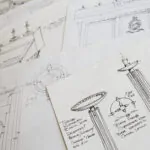differences between utility and design patent drawings, the importance of shading and hatching, and how to respond effectively to an office action from the USPTO.
1. Difference Between Utility and Design Patent Drawings:
Understanding the distinction between utility and design patent drawings is fundamental. Utility patents focus on the functionality and structure of an invention, requiring detailed drawings that illustrate how the invention works. On the other hand, design patents primarily protect the ornamental design or aesthetics of an object, necessitating drawings that highlight the visual aspects.
When creating utility patent drawings, it is essential to emphasize the invention’s functionality, emphasizing the unique features that contribute to its utility.
2. Shading and Hatching in Utility Patent Drawings:
Shading and hatching play a vital role in utility patent drawings, helping to convey depth, dimension, and different materials within the invention. Proper use of shading and hatching adds clarity to the drawings and aids in understanding the various components of the invention.
3. Guidelines for shading and hatching:
Use consistent shading techniques throughout the drawings.
- Ensure that shading does not obscure essential details.
- Clearly differentiate between different materials or parts through appropriate shading.
- Maintaining consistency in shading and hatching contributes to the overall professionalism of the utility patent drawings.
4. Guidelines for Creating Utility Patent Drawings:
Clarity and Detail: Utility patent drawings should be clear, precise, and sufficiently detailed to convey the intricacies of the invention. Ambiguity in the drawings may lead to potential issues during the patent
examination process.
Multiple Views: Provide multiple views of the invention, including perspective, top, bottom, side, and cross-sectional views if necessary. This ensures a comprehensive understanding of the invention from various angles.
Labeling and Numbering: Clearly label each element in the drawing and use numeric identifiers to reference these elements in the patent description. Consistent labeling enhances the overall coherence of the patent
application.
Proportions and Scaling: Maintain accurate proportions and scaling in the drawings to ensure that the relative sizes of different components are represented correctly. This contributes to the precision and accuracy of the utility patent drawings.
5. Responding to Office Action by USPTO:
When the United States Patent and Trademark Office (USPTO) issues an office action, it signifies that there are issues or objections with the utility patent application, including the drawings. To respond effectively:
Carefully Review the Office Action: Thoroughly understand the concerns raised by the USPTO in the office action.
Address the Concerns: Address each concern methodically, providing clear explanations, amendments, or additional information as needed.
Seek Professional Assistance: If the issues are complex or require legal expertise, consider seeking assistance from patent professionals or attorneys experienced in responding to office actions.
Conclusion:
Creating utility patent drawings involves adhering to
specific guidelines to ensure the clarity, accuracy, and comprehensiveness of
the visual representation of an invention. Understanding the differences
between utility and design patent drawings, mastering shading and hatching
techniques, and knowing how to respond to office actions are critical aspects
of navigating the utility patent application process successfully. By following
these guidelines, inventors can enhance their chances of obtaining robust utility
patents that protect their innovations effectively.








